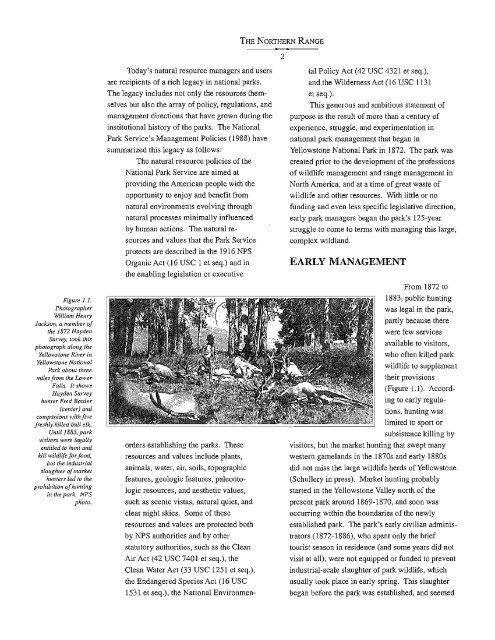Yellowstone's Northern Range - Greater Yellowstone Science ...
Yellowstone's Northern Range - Greater Yellowstone Science ...
Yellowstone's Northern Range - Greater Yellowstone Science ...
Create successful ePaper yourself
Turn your PDF publications into a flip-book with our unique Google optimized e-Paper software.
THE NORTHERN RANGE<br />
2<br />
Figure 1.1.<br />
Photographer<br />
William Henry<br />
Jackson, a member of<br />
the 1872 Hayden<br />
Survey, took this<br />
photograph along the<br />
<strong>Yellowstone</strong> River in<br />
<strong>Yellowstone</strong> National<br />
Park about three<br />
miles from the Lower<br />
Falls. It shows<br />
Hayden Survey<br />
hunter Fred Bottler<br />
(center) and<br />
companions with five<br />
freshly killed bull elk.<br />
Until 1883, park<br />
visitors were legally<br />
elltitled to hunt and<br />
kill wildlife for food,<br />
but the industrial<br />
slaughter of market<br />
hunters led to the<br />
prohibition of hunting<br />
in the park. NPS<br />
photo.<br />
Today's natural resource managers and users<br />
are recipients of a rich legacy in national parks.<br />
The legacy includes not only the resources themselves<br />
but also the array of policy, regulations, and<br />
management directions that have grown during the<br />
institutional history of the parks. The National<br />
Park Service's Management Policies (1988) have<br />
summatized this legacy as follows:<br />
The natural resource policies of the<br />
National Park Service are aimed at<br />
providing the American people with the<br />
opportunity to enjoy and benefit from<br />
natural environments evolving through<br />
natural processes minimally influenced<br />
by human actions. The natural resources<br />
and values that the Park Service<br />
protects are described in the 1916 NPS<br />
Organic Act (16 USC I et seq.) and in<br />
the enabling legislation or executive<br />
orders establishing the parks. These<br />
resources and values include plants,<br />
animals, water, air, soils, topographic<br />
features, geologic features, paleontologic<br />
resources, and aesthetic values,<br />
such as scenic vistas, natural quiet, and<br />
clear night skies. Some of these<br />
resources and values are protected both<br />
by NPS authorities and by other<br />
statutory authorities, such as the Clean<br />
Air Act (42 USC 7401 et seq.), the<br />
Clean Water Act (33 USC 1251 et seq.),<br />
the Endangered Species Act (16 USC<br />
1531 et seq.), the National Environmen-<br />
tal Policy Act (42 USC 4321 et seq.),<br />
and the Wilderness Act (16 USC 1131<br />
et seq.).<br />
This generous and ambitious statement of<br />
purpose is the result of more than a century of<br />
experience, struggle, and experimentation in<br />
national park management that began in<br />
<strong>Yellowstone</strong> National Park in 1872. The park was<br />
created prior to the development of the professions<br />
of wildlife management and range management in<br />
North America, and at a time of great waste of<br />
wildlife and other resources. With little or no<br />
funding and even less specific legislative direction,<br />
early park managers began the park's 125-year<br />
struggle to come to terms with managing this large,<br />
complex wildland.<br />
EARLY MANAGEMENT<br />
From 1872 to<br />
1883, public hunting<br />
was legal in the park,<br />
partly because there<br />
were few services<br />
available to visitors,<br />
who often killed park<br />
wildlife to supplement<br />
their provisions<br />
(Figure 1.1). According<br />
to early regulations,<br />
hunting was<br />
limited to sport or<br />
subsistence killing by<br />
visitors, but the market hunting that swept many<br />
western gamelands in the 1870s and early 1880s<br />
did not miss the large wildlife herds of <strong>Yellowstone</strong><br />
(Schullery in press). Market hunting probably<br />
started in the <strong>Yellowstone</strong> Valley north of the<br />
present park around 1869-1870, and soon was<br />
occurring within the boundaries of the newly<br />
established park. The park's early civilian administrators<br />
(1872-1886), who spent only the brief<br />
tourist season in residence (and some years did not<br />
visit at all), were not equipped or funded to prevent<br />
industrial-scale slaughter of park wildlife, which<br />
usually took place in early spring. This slaughter<br />
began before the park was established, and seemed















